
The Ministry of Foreign Affairs is responsible for managing the foreign relations of Brazil. Brazil is a significant political and economic power in Latin America and a key player on the world stage. Brazil's foreign policy reflects its role as a regional power and a potential world power and is designed to help protect the country's national interests, national security, ideological goals, and economic prosperity.

Demographic features of the population of Portugal include population density, ethnicity, education level, health of the populace, economic status, religious affiliations and other aspects of the population.
Latin Americans are the citizens of Latin American countries.
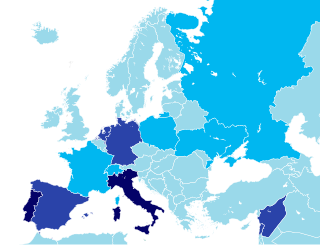
Immigration to Brazil is the movement to Brazil of foreign peoples to reside permanently. It should not be confused with the forcible bringing of people from Africa as slaves. Latin Europe accounted for four-fifths of the arrivals. This engendered a strikingly multicultural society. Yet over a few generations, Brazil absorbed these new populations in a manner that resembles the experience of the rest of the New World.

The Brazilian diaspora is the migration of Brazilians to other countries, a mostly recent phenomenon that has been driven mainly by economic recession and hyperinflation that afflicted Brazil in the 1980s and early 1990s, and since 2014, by the political and economic crisis that culminated in the impeachment of Dilma Rousseff in 2016 and the election of Jair Bolsonaro in 2018, in addition to chronic violence in Brazilian urban centers.

Immigration to Spain increased significantly in the beginning of the 21st century. In 1998, immigrants accounted for 1.6% of the population, and by 2009, that number had risen to over 12%. Until 2014, the numbers were decreasing due to the economic crisis, but since 2015, immigration to Spain has increased again, especially after 2021.

Brazil–Russia relations have seen significant improvement in recent years, characterized by increased commercial trades and cooperation in military and technology segments. The two countries maintain important partnerships in areas such as space, military technologies, and telecommunications.
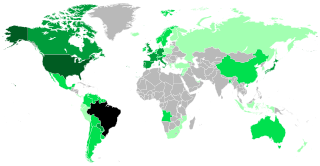
Brazilians are the citizens of Brazil. A Brazilian can also be a person born abroad to a Brazilian parent or legal guardian as well as a person who acquired Brazilian citizenship. Brazil is a multiethnic society, which means that it is home to people of many ethnic origins, and there is no correlation between one's stock and their Brazilian identity.

Immigration to Europe has a long history, but increased substantially after World War II. Western European countries, especially, saw high growth in immigration post 1945, and many European nations today have sizeable immigrant populations, both of European and non-European origin. In contemporary globalization, migrations to Europe have accelerated in speed and scale. Over the last decades, there has been an increase in negative attitudes towards immigration, and many studies have emphasized marked differences in the strength of anti-immigrant attitudes among European countries.
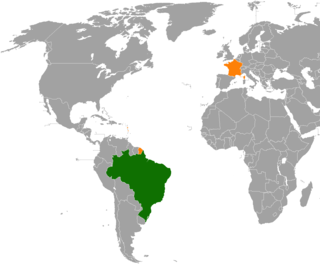
Brazil–France relations are the bilateral relations between the Federative Republic of Brazil and the French Republic.

As of December 2022, Portugal had 1,683,829 inhabitants that were born in a foreign country, out of 10,467,366 inhabitants, accounting for 16.1% of its total population.
The Ministry of External Relations is the Angolan government ministry which oversees the foreign relations of Angola. Tete António is the current foreign minister since 9 April 2020.
Brazilian Australians refers to Australian citizens of Brazilian birth or descent.
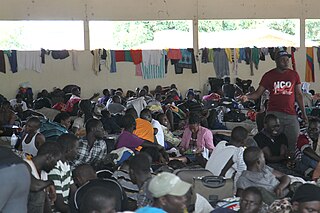
A Haitian Brazilian is a Brazilian person of full, partial, or predominantly Haitian ancestry, or a Haitian-born person residing in Brazil.

Haiti was one of the original members of the League of Nations, and was one of the original members of the United Nations and several of its specialized and related agencies. It is also a founding member of the Organization of American States. Haiti also has diplomatic relations with the Republic of China, commonly known as Taiwan, instead of the People's Republic of China. Taiwan is one of Haiti's major trading partners and the two countries maintain very friendly relations. Haiti has also re-established very warm relations with Cuba in which a major act of bilateral cooperation has resulted in Cuba's large contribution of doctors to the country. The Haitian government has publicly shown admiration to Fidel Castro and his administration.
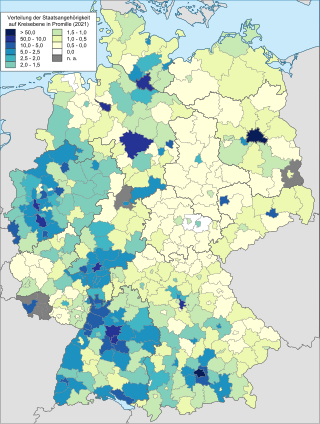
Brazilians in Germany consists mainly of immigrants and expatriates from Brazil as well as their locally born descendants. Many of them consist of German Brazilian returnees. According to Brazil's foreign relations department, there are about 144,120 Brazilians living in Germany.

Immigration to Vietnam is the process by which people migrate to become Vietnamese residents. After the declaration of independence in 1945, immigration laws were modified to give the central government some control over immigrant workers arriving from nearby South Asian countries such as China, Cambodia, Laos, the Philippines, and Thailand. The Vietnam Immigration Department recently relaxed the strict controls on immigrant workers under Decree 21/2001/ND-CP, 34/2008/NĐ-CP and 46/2011/NĐ-CP.

Dominicans in Spain from the Dominican Republic make up about 1.66% of all foreigners in Spain, this includes immigrants and people of Dominican descent born in Spain. The first country of destination for Dominicans in Europe is Spain, and it is the country with the most Dominican migrants outside of the United States.
Latin American migration to Europe is the diaspora of Latin Americans to the continent of Europe, dating back to the first decades of the Spanish and Portuguese empires in the Americas. Latin Americans in Europe are now a rapidly growing group consisting of immigrants from Argentina, Bolivia, Brazil, Chile, Colombia, Costa Rica, Cuba, Dominican Republic, Ecuador, El Salvador, Guatemala, Honduras, Mexico, Nicaragua, Panama, Paraguay, Peru, Puerto Rico, Uruguay and Venezuela. It may also include individuals from certain French-speaking territories depending on the definition of Latin America used.
Portuguese in Sweden are citizens and residents of Sweden who are of Portuguese descent.

































